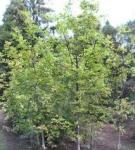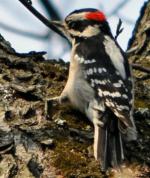Riparian Woodland and Forest
Riparian woodlands and forests are rare, covering just over 11,000 acres (2%) of Napa County. Riparian is the specific ecosystem that surround the banks of rivers and streams. The County's riparian woodlands are mostly found in the Western Mountains and the Napa Valley floor. These are the areas with the most water and the densest plant cover, providing key habitat needs like protection from predators, shade, breeding and nesting areas, and food.
Across the State, over 300 species of birds, mammals, reptiles and amphibians depend on riparian habitats. The individuals in a riparian community have specific adaptations for living in repeatedly flooded environments. Riparian forests provide critical wildlife habitat for migratory songbirds, waterfowl, Chinook salmon, steelhead, and a host of other species. Because of the incredible diversity they support, riparian areas are called the "Rainforests of California" (RiverPartners.org).
Riparian forests often include California bay, Oregon ash, willows, valley oak, and coast live oak. The understory quit often includes mulefat (Baccharis salicifolia), torrent sedge (Carex nudata), and western azalea (Rhododendron occidentale).
Trees

Oregon ash
Fraxinus latifolia

Willow
Salix spp.

Coast live oak
Quercus agrifolia
Understory

Mulefat
(Baccharis salicifolia)

Western azalea
(Rhododendron occidentale)

Torrent sedge
(Carex nudata)
Wildlife habitat is greatly enhanced by riparian vegetation, which provides shade, food, and nutrients. While coarse wood debris from riparian trees and shrubs provide protection, they are also an important feature of in-stream habitat forming scour pools for fish, insects, and amphibians. Amphibians found in riparian woodland and forests include the Pacific tree frog (Hyla regilla). Birds include the downy woodpecker (Picoides pubescens) and the yellow warbler (Dendroica petechial brewsteri). Mammals include the desert cotton tail (Sylvilagus bachmanii) and the sonoma chipmunk (Tamias sonomae).
Reptiles and Amphibians

Pacific tree frog
Hyla regilla
Birds

Yellow warbler
Setophaga petechia

Downy woodpecker
Picoides pubescens
Mammals

Desert cottontail
(Sylvilagus bachmanii)

Sonoma chipmunk
(Tamias sonomae)
The primary ecosystem functions of riparian woodlands and forest in the County are:
- Stabilize streambanks
- Maintain cool water temperatures
- Maintain water quality through soil retention and by filtering out sediment and nutrients from run-off
- Maintain stream flows into summer by promoting groundwater recharge and storing water
- Prevent flooding and minimize channel erosion by slowing surface run-off
- Provide movement areas for wildlife
- Provide wildlife habitat directly and through the input of coarse woody debris and detritus into streams and rivers
- Provide opportunities for recreation including, but not limited to, hunting, bird-watching, hiking, horseback riding, off-road vehicle
Use the map below to explore the various biotic communities throughout Napa County.


